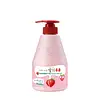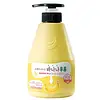What's inside
What's inside
 Key Ingredients
Key Ingredients

 Benefits
Benefits

 Concerns
Concerns

 Ingredients Side-by-side
Ingredients Side-by-side

Water
Skin ConditioningAmmonium Lauryl Sulfate
CleansingAmmonium Laureth Sulfate
CleansingCocamidopropyl Betaine
CleansingSodium Chloride
MaskingStyrene/Vp Copolymer
Fragaria Chiloensis Fruit Extract
Skin ConditioningSodium Sulfate
Laureth-3
EmulsifyingCitric Acid
BufferingButylene Glycol
HumectantPanthenol
Skin ConditioningHoney Extract
HumectantAlcohol
AntimicrobialMilk Protein Extract
Propolis Extract
Skin ConditioningRoyal Jelly Extract
Skin ConditioningDisodium EDTA
Sodium Benzoate
MaskingPhenoxyethanol
PreservativeCI 19140
Cosmetic ColorantCI 17200
Cosmetic ColorantParfum
MaskingLinalool
PerfumingWater, Ammonium Lauryl Sulfate, Ammonium Laureth Sulfate, Cocamidopropyl Betaine, Sodium Chloride, Styrene/Vp Copolymer, Fragaria Chiloensis Fruit Extract, Sodium Sulfate, Laureth-3, Citric Acid, Butylene Glycol, Panthenol, Honey Extract, Alcohol, Milk Protein Extract, Propolis Extract, Royal Jelly Extract, Disodium EDTA, Sodium Benzoate, Phenoxyethanol, CI 19140, CI 17200, Parfum, Linalool
Water
Skin ConditioningParaffinum Liquidum
EmollientGlycerin
HumectantButylene Glycol
HumectantCaprylic/Capric Triglyceride
MaskingDimethicone
EmollientCetearyl Alcohol
EmollientArachidyl Alcohol
EmollientSorbitan Sesquioleate
EmulsifyingBehenyl Alcohol
EmollientGlyceryl Stearate
EmollientPEG-100 Stearate
Stearyl Alcohol
EmollientCarbomer
Emulsion StabilisingArachidyl Glucoside
EmulsifyingMusa Sapientum Fruit Extract
Skin ConditioningPotassium Hydroxide
BufferingXanthan Gum
EmulsifyingPanthenol
Skin ConditioningMyristyl Alcohol
EmollientLauryl Alcohol
EmollientAlcohol Denat.
AntimicrobialHoney Extract
HumectantGlucose
HumectantMilk Protein Extract
Propolis Extract
Skin Conditioning1,2-Hexanediol
Skin ConditioningTris(Tetramethylhydroxypiperidinol)Citrate
StabilisingDisodium EDTA
Phenoxyethanol
PreservativeChlorphenesin
AntimicrobialCI 19140
Cosmetic ColorantCI 15985
Cosmetic ColorantParfum
MaskingLimonene
PerfumingLinalool
PerfumingWater, Paraffinum Liquidum, Glycerin, Butylene Glycol, Caprylic/Capric Triglyceride, Dimethicone, Cetearyl Alcohol, Arachidyl Alcohol, Sorbitan Sesquioleate, Behenyl Alcohol, Glyceryl Stearate, PEG-100 Stearate, Stearyl Alcohol, Carbomer, Arachidyl Glucoside, Musa Sapientum Fruit Extract, Potassium Hydroxide, Xanthan Gum, Panthenol, Myristyl Alcohol, Lauryl Alcohol, Alcohol Denat., Honey Extract, Glucose, Milk Protein Extract, Propolis Extract, 1,2-Hexanediol, Tris(Tetramethylhydroxypiperidinol)Citrate, Disodium EDTA, Phenoxyethanol, Chlorphenesin, CI 19140, CI 15985, Parfum, Limonene, Linalool
 Reviews
Reviews

Ingredients Explained
These ingredients are found in both products.
Ingredients higher up in an ingredient list are typically present in a larger amount.
Butylene Glycol (or BG) is used within cosmetic products for a few different reasons:
Overall, Butylene Glycol is a safe and well-rounded ingredient that works well with other ingredients.
Though this ingredient works well with most skin types, some people with sensitive skin may experience a reaction such as allergic rashes, closed comedones, or itchiness.
Learn more about Butylene GlycolCI 19140 is also known as Tartrazine. Tartrazine is a synthetic dye used in cosmetics, foods, and medicine to add a yellow color.
Tartrazine is created from petroleum and is water-soluble.
Some people may experience allergies from this dye, especially asthmatics and those with an aspirin intolerance.
Learn more about CI 19140Disodium EDTA plays a role in making products more stable by aiding other preservatives.
It is a chelating agent, meaning it neutralizes metal ions that may be found in a product.
Disodium EDTA is a salt of edetic acid and is found to be safe in cosmetic ingredients.
Learn more about Disodium EDTAThis ingredient comes from honey made by bees. It is hydrating, antibacterial, anti-aging, and skin soothing.
Honey also contains amino acids, peptides, Vitamins A, C, and E.
The humectant property of honey draws moisture from the air to your skin. This makes it great at helping to hydrate the skin.
Honey may help reduce the signs of aging due to its antioxidant properties. Fun fact: darker honey has more antioxidants than light honey. The antibacterial property of honey may make it effective at helping to treat acne by killing acne-causing bacteria.
Many people wonder if honey extract is vegan. It is technically a byproduct from bees. This is because honey is created from the digestive enzymes in a bee's stomach.
Remember to be kind to bees :) They are important for many ecosystems and are endangered.
Learn more about Honey ExtractLinalool is a fragrance and helps add scent to products. It's derived from common plants such as cinnamon, mint, citrus, and lavender.
Like Limonene, this ingredient oxidizes when exposed to air. Oxidized linalool can cause allergies and skin sensitivity.
This ingredient has a scent that is floral, spicy tropical, and citrus-like.
Learn more about LinaloolWe don't have a description for Milk Protein Extract yet.
Panthenol is a common ingredient that helps hydrate and soothe the skin. It is found naturally in our skin and hair.
There are two forms of panthenol: D and L.
D-panthenol is also known as dexpanthenol. Most cosmetics use dexpanthenol or a mixture of D and L-panthenol.
Panthenol is famous due to its ability to go deeper into the skin's layers. Using this ingredient has numerous pros (and no cons):
Like hyaluronic acid, panthenol is a humectant. Humectants are able to bind and hold large amounts of water to keep skin hydrated.
This ingredient works well for wound healing. It works by increasing tissue in the wound and helps close open wounds.
Once oxidized, panthenol converts to pantothenic acid. Panthothenic acid is found in all living cells.
This ingredient is also referred to as pro-vitamin B5.
Learn more about PanthenolParfum is a catch-all term for an ingredient or more that is used to give a scent to products.
Also called "fragrance", this ingredient can be a blend of hundreds of chemicals or plant oils. This means every product with "fragrance" or "parfum" in the ingredients list is a different mixture.
For instance, Habanolide is a proprietary trade name for a specific aroma chemical. When used as a fragrance ingredient in cosmetics, most aroma chemicals fall under the broad labeling category of “FRAGRANCE” or “PARFUM” according to EU and US regulations.
The term 'parfum' or 'fragrance' is not regulated in many countries. In many cases, it is up to the brand to define this term.
For instance, many brands choose to label themselves as "fragrance-free" because they are not using synthetic fragrances. However, their products may still contain ingredients such as essential oils that are considered a fragrance by INCI standards.
One example is Calendula flower extract. Calendula is an essential oil that still imparts a scent or 'fragrance'.
Depending on the blend, the ingredients in the mixture can cause allergies and sensitivities on the skin. Some ingredients that are known EU allergens include linalool and citronellol.
Parfum can also be used to mask or cover an unpleasant scent.
The bottom line is: not all fragrances/parfum/ingredients are created equally. If you are worried about fragrances, we recommend taking a closer look at an ingredient. And of course, we always recommend speaking with a professional.
Learn more about ParfumPhenoxyethanol is a preservative that has germicide, antimicrobial, and aromatic properties. Studies show that phenoxyethanol can prevent microbial growth. By itself, it has a scent that is similar to that of a rose.
It's often used in formulations along with Caprylyl Glycol to preserve the shelf life of products.
Propolis Extract is also known as bee glue.
This ingredient has antimicrobial, anti-inflammatory, wound healing, and antioxidant properties.
Studies show propolis helps fight against bacteria, viruses, and fungi. This may help with reducing acne and accelerate wound healing.
The flavonoids found in propolis extract are potent antioxidants. Antioxidants may help with reducing the signs of aging.
A study from 2020 found propolis to help reverse skin damage from UV.
Fun facts: This ingredient is created by mixing beeswax, bee saliva, and parts of trees. Bees use propolis as a sealant to close any gaps in their hives.
Since it is an animal-derived product, this ingredient is not considered vegan. For vegan alternatives, check out Galactomyces Ferment Filtrate or Centella Asiatica Extract.
Learn more about Propolis ExtractWater. It's the most common cosmetic ingredient of all. You'll usually see it at the top of ingredient lists, meaning that it makes up the largest part of the product.
So why is it so popular? Water most often acts as a solvent - this means that it helps dissolve other ingredients into the formulation.
You'll also recognize water as that liquid we all need to stay alive. If you see this, drink a glass of water. Stay hydrated!
Learn more about Water